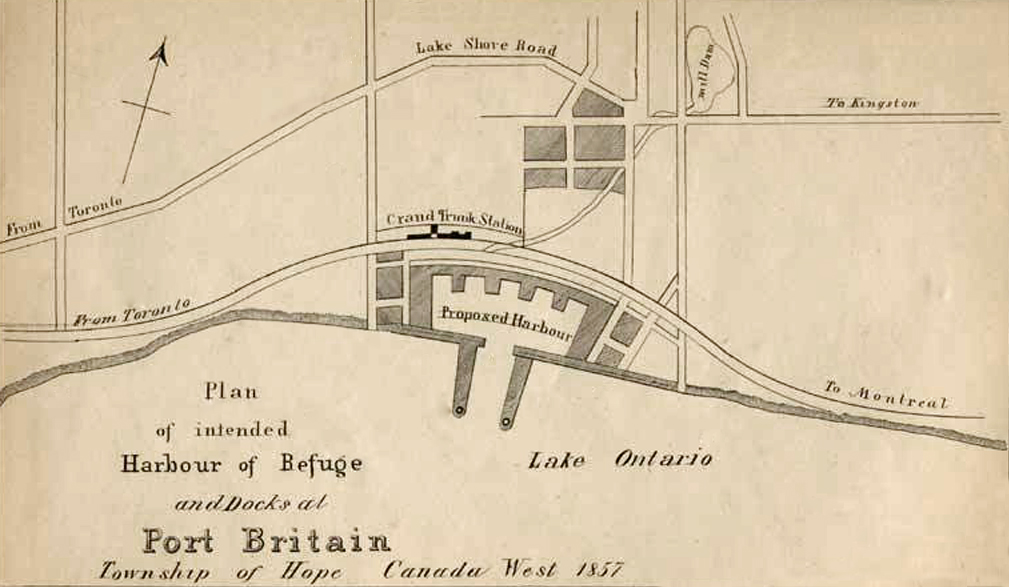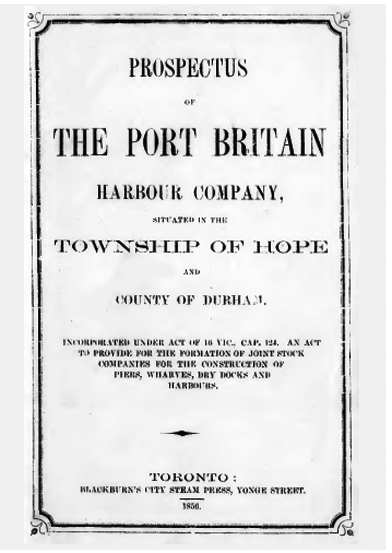
Plan of proposed harbour of refuge, Port Britain 1857.
PROSPECTUS OF THE PORT BRITAIN HARBOUR COMPANY. (click here to view PDF version of the prospectus)
 Port Britain is situated on Lake Ontario, in the centre of the Township of Hope and County of Durham, known to be one of the best wheat growing sections of Canada. The country to the rear of it and directly its tributary, is unsurpassed for fertility of soil and quality of its productions. There are several grist mills, sawmills, and distilleries in its immediate vicinity, it is sixty miles to the eastward of Toronto, and about
equal distance from Belleville, at the head of navigation of the Bay of
Quinte. It lies to the westward of the Town of Cobourg and contiguous to Port Hope, and nearly opposite to the City of Rochester, from which it is distant only about sixty miles.
Port Britain is situated on Lake Ontario, in the centre of the Township of Hope and County of Durham, known to be one of the best wheat growing sections of Canada. The country to the rear of it and directly its tributary, is unsurpassed for fertility of soil and quality of its productions. There are several grist mills, sawmills, and distilleries in its immediate vicinity, it is sixty miles to the eastward of Toronto, and about
equal distance from Belleville, at the head of navigation of the Bay of
Quinte. It lies to the westward of the Town of Cobourg and contiguous to Port Hope, and nearly opposite to the City of Rochester, from which it is distant only about sixty miles.Port Britain presents natural advantages for a harbour, unequalled by any port on Lake Ontario; surrounded by hills and heavy bluffs jutting out into the Lake, it forms a secluded bay in which vessels may seek shelter and safely ride out the most severe storm.
The highest engineering and nautical talent of the country have pronounced it to be the place best adapted for a harbour of refuge. Unlike most of the ports on Lake Ontario, it has good anchorage outside (blue clay,) and any vessel which might miss the harbour would be sure to hold on in safety by her anchor.
The inner harbour is proposed to be formed inside the present line of lake beach, where there now exists a natural basin of about twelve acres of deep water, along two sides of which it is proposed to pile so as to form commodious wharves, and to open a channel two hundred feet wide through the beach to twelve feet deep water, which it is intended to protect with cribbing on both sides.
Added to these natural advantages, the Grand Trunk Railway of Canada have erected a Station at this point; this, coupled with the fact that it is the only place where the line of railway comes to a convenient grade above the level of the lake, for shipping purposes, forces the conclusion that it will eventually be the place from which transhipment must be made for all freights and merchandise shipped from New York, Boston, and Philadelphia, via the eastern ports and Rochester, thence across Lake Ontario, for all places in connection with the Grand Trunk Railway, the Great Western Railway, and Chicago, over the Ontario, Simcoe, and Huron Railway, without cost of carriage, storage, or excessive harbour dues, transhipment being made direct from the vessel to the cars, and vice versa.
To the wheat and produce buyer, the miller and lumberman, this place presents inestimable advantages, and particularly to them who these remarks apply. The opportunity now offering for each to own the lot on which to build his own storehouse and personally control his property therein.
It is estimated that a safe and commodious harhour can be made at the above named place, with piers running out six hundred feet into Lake Ontario, to twelve feet depth at low water mark, and an inner harbour of about twelve acres in size, with wharves, cranes, and all necessary erections, and railway connections with the Grand Trunk Railway, for carrying on an extensive shipping and forwarding business, taking in a mile of water frontage on Lake Ontario; also including forty-five acres of land (more or less,) for the sum of twelve thousand pounds, currency, (forty-eight thousand dollars,)
It is proposed to raise the above amount in two thousand four hundred shares at five pounds (twenty dollars) each share. The payments, or installments on the shares, will he controlled by the directors as they may be required to carry on the work, but as it is the intention of the directors to have the harbour ready to receive steamers and vessels alongside of the Grand Trunk Railway line on the first day of July, A D 1857, the full amount of each share will be required by the first day of August, A D 1857.
The forty-five acres of land, together with the water frontage appertaining thereto, (being that portion of lots 21 and 22, broken front, and first concession of the Township of Hope and County of Durham, lying south of the track of the Grand Trunk Railway of Canada,) will be charged for at the rate of one hundred pounds per acre — say four thousand five hundred pounds (or eighteen thousand dollars.)
This amount will be taken in stock of the Company, and the fee simple of the land will be given to them in their corporate capacity as soon as stock to that amount is issued. The control of the extra half mile of the waters of Lake Ontario — that is to say, one-quarter of a mile to the east and one-quarter of a mile to the westward of the aforesaid forty-five acres of land so set aside for harbour purposes of the proposed harbour, (being the water fronts respectively of lots twenty and twenty-three, in the first concession and broken fronts of the Township of Hope aforesaid,) will also be given by the proprietor to the company, except the right of fishing, which the proprietor exclusively reserves over the whole.
Possessing natural advantages in so eminent a degree as does Port Britain, it follows that from its position, the cost of construction of the harbour will be but slight, and as an investment to the capitalist it will rank second to none in the province. It will be seen that the company will have the fee simple of forty-five acres of land. It is computed that twelve acres will be required for the inner harbour, leaving thirty-three acres for building sites, storehouses, warehouses etc. On the completion of the harbour the stockholders will be able to sell this surplus at a great advance on its original cost, it is not unreasonable to suppose that it will quadruple its value, and this in little more than six months. The high rates of land sales that have lately taken place in Cobourg, Port Hope, Bowmanville, Whitby, and other places on the line of railway where there has only been a station, are proofs of it. Much more must then be expected, when there is both a harbour and station.
Land adjoining the harbour at Port Hope has lately changed hands at the rate of £1237 10s per acre!
In this case it is clear, that as soon as the harbour is constructed, the sale of the surplus lands will pay back to the stockholder all the money advanced, together with a large profit, and give him his stock in the harbour free of all cost.
This then, is a safe, certain, and splendid investment, for not only is it shown that the money subscribed by the stockholder will be returned to him in one year on the sale of the surplus lands, but returns of other harbours on the north shore of Lake Ontario, show an increase of nearly double their revenues since the Reciprocity Treaty came into force; and the opening of the Grand Trunk Railway, will turn the current of travel hitherward, Rochester being the best connection the eastern travel can have with the Great West, but that it is making a very low estimate to presume this scheme will return at least twenty per cent on the capital stock of the Company. The revenues of the harbours on the north shore of the lake in this immediate neighbourhood, have increased from about £1200 in 1852 to £7000 in 1856.
A. DE GRASSI,
Secretary and Treasurer.
Toronto, 9th December 1856.